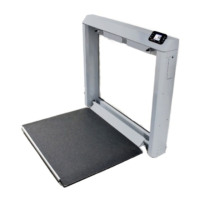0065-0647-OM Rev E 7550 OWNER’S MANUAL
CALIBRATE SCALE
Calibration Modes
The 7550 Wall-Mount Fold-Up Wheelchair Scale has four modes that can be used to perform
calibration. The modes are as follows:
1 = SMARTCAL
SmartCal is the most precise method of calibration. It requires that a calibrated load be
placed over each load cell of the scale platform only once. In this method, the scale will be
able to derive calibration constants, which will be used to combine information from each
load cell into scale weight.
During SmartCal, the display will prompt for the test load to be applied over a particular load
cell. With a scale that has four load cells, the order will simply be cell 1, cell 2, cell 3, and
cell 4. This order is used so that calibration can be done using a test weight with a minimal
amount of maneuvering required. Refer to the illustration below.
(Test Weight)
Load Cell and Load Placement
2 = Two Calibration Points
This is a standard calibration method requiring an empty scale and one weight. This method
uses two calibration points (an empty scale and the full test load on the scale) to establish a
zero (no load) calibration value and to span the indicator.
3 = Three Calibration Points
This method requires an empty scale, two weights, and uses three calibration points (an
empty scale, half the test load, and the full test load on the scale). The three points
correspond to zero (no load) weight, mid-point weight, and test load (weight).
4 = Four Calibration Points
This method requires an empty scale, three weights, and uses four calibration points (an
empty scale, one-fourth of the test load, half the test load, and the full test load on the
scale). The four points correspond to zero weight, quarter-point weight, mid-point weight,
and test load (weight).
4
LOAD
3
1
2
NOTE: This is the side of the
scale against the wall.

